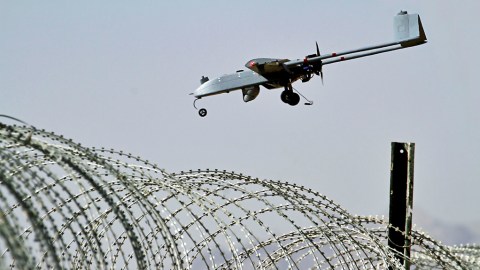A Nuclear-Powered Drone? Fantasy. DIY Drones? Reality.

This is a tale of two drones. Or rather, two types of drones. One is the stuff of crazy science fiction. The other is fast becoming a reality. Now here’s the twist: individuals are making DIY drones a reality while large government-sponsored researchers in some cases are the ones writing the science fiction.
What’s the Big Idea?
The DIY revolution is outlined in great detail Peter Diamandis and Steven Kotler’s new book, Abundance: Why the Future Will Be Much Better Than You Think. The authors point to Wired editor in chief Chris Anderson’s burgeoning online DIY Drone movement, which is producing homebrew unmanned air vehicles (UAVs) for as little as $300. One of the models, in fact, has 90 percent of the functionality as military grade drones.
As the Associated Press pointed out, the drop in drone prices over the last few years is closely connected to the ubiquity of smart phones. Think of your smart phone as an autopilot device: it can locate itself on a map and determine whether it is being held vertically or horizontally. It’s the same computer chip used in drones.
What’s the Significance?
Drones have not only transformed 21st century warfare. They can be used by small groups or individuals who can now get access to places that were previously unaccessible. Occupy Wall Street, for instance, launched the Occucopter to “occupy the airspace” and monitor police activity.
Of course, police and security forces use drones as well, outfitted with license plate scanners and face recognition systems. But media outlets can also use drones to cast a wider surveillance net and keep the powers that be in check. You no longer need an expensive news helicopter.
There are also notable uses for drones in agriculture and biological research. For instance, drones can be used to map deforestation and detect dry patches in orchards. Drones can also be used by search and rescue squads, real estate agents and land surveyors, anti-whaling activists, filmmakers, cattle ranchers, not to mention hobbyists out to have some fun.
So what is holding back DIY drones as well as military drones?
Both face the same problem, just on a different scale. If you carry out the analogy of the smart phone-as-drone, it is easy to understand that one of this technology’s great shortcomings is battery life. The military drones have the same problem, and that is why the government has investigated the nuclear option.
“Faster, higher, deadlier: US plans nuclear drones”
That was one of the many headlines that appeared this week after it was announced that scientists at the government research and development agency Sandia National Laboratories had developed plans for a nuclear-powered drone. This UAV would be capable of flying for months without refueling, and the project was was completed, at least on paper. You can read all about in this Project Accomplishment Summary (PDF).
According to the report, “the greatest shortfalls in UAV capabilities have been repeatedly identified as
1) insufficient flight persistence or “hang time”
2) marginal electrical power for running higher power avionics and payload systems, and
3) inadequate communications bandwidth and reach.
The Sandia team investigated energy storage and power generation concepts that would most increase “UAV sortie duration from days to months while increasing available electrical power at least two-fold.”
The winning concept, of course, was nuclear. But you have to read between the lines in the report to understand that conclusion. The document does not mention the word “nuclear,” but does mention concerns about “decommissioning and disposal.”
But don’t worry too much. “The results will not be applied/implemented,” the document concludes.
What Does the Future Hold?
It is conceivable that unmanned, nuclear-powered drones could be developed in the future, but a number of serious engineering challenges would need to be overcome, and considerable risks set aside.
The fact of the matter is, drones don’t have a great safety record. They crasha lot, and sometimes kill the wrong people. Worse yet, what if a nuclear-powered drone got into the hands of rogue states or terrorists? After all, we can’t keep sensitive drone technology out of Iranian hands as it is.
So while nuclear-powered drones remain the stuff of science fiction, the growing DIY movement to hack the physical world is on the rise. And yet, at some point, the notion of an unmanned drone might be seen as passe. For instance, a Dutch company plans to bring a car to market in 2014 called the PAL-V (Personal Air and Land Vehicle), which uses “advanced gyrocopter technology” to fly.
Watch the video of their demonstration here:
A company called Terrafugia will unveil a rival flying car model at the New York Auto Show this week.
Image courtesy of Shutterstock
Follow Daniel Honan on Twitter @Daniel Honan





